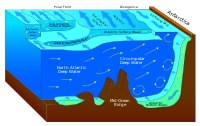
Photo from wikipedia
Understanding the drivers of surface melting in West Antarctica is crucial for understanding future ice loss and global sea level rise. This study identifies atmospheric drivers of surface melt on… Click to show full abstract
Understanding the drivers of surface melting in West Antarctica is crucial for understanding future ice loss and global sea level rise. This study identifies atmospheric drivers of surface melt on West Antarctic ice shelves and ice sheet margins and relationships with tropical Pacific and high-latitude climate forcing using multidecadal reanalysis and satellite datasets. Physical drivers of ice melt are diagnosed by comparing satellite-observed melt patterns to anomalies of reanalysis near-surface air temperature, winds, and satellite-derived cloud cover, radiative fluxes, and sea ice concentration based on an Antarctic summer synoptic climatology spanning 1979–2017. Summer warming in West Antarctica is favored by Amundsen Sea (AS) blocking activity and a negative phase of the southern annular mode (SAM), which both correlate with El Niño conditions in the tropical Pacific Ocean. Extensive melt events on the Ross–Amundsen sector of the West Antarctic Ice Sheet (WAIS) are linked to persistent, intense AS blocking anticyclones, which force intrusions of marine air over the ice sheet. Surface melting is primarily driven by enhanced downwelling longwave radiation from clouds and a warm, moist atmosphere and by turbulent mixing of sensible heat to the surface by föhn winds. Since the late 1990s, concurrent with ocean-driven WAIS mass loss, summer surface melt occurrence has increased from the Amundsen Sea Embayment to the eastern Ross Ice Shelf. We link this change to increasing anticyclonic advection of marine air into West Antarctica, amplified by increasing air–sea fluxes associated with declining sea ice concentration in the coastal Ross–Amundsen Seas.
Journal Title: Journal of Climate
Year Published: 2019
Link to full text (if available)
Share on Social Media: Sign Up to like & get
recommendations!